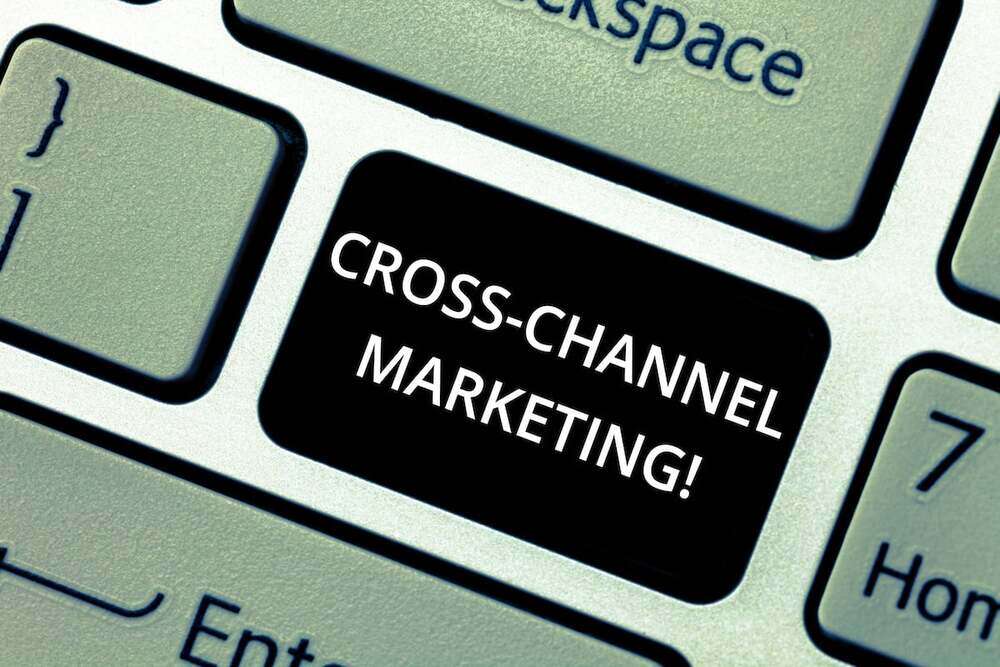Marketing
8
min read
Cross-Channel Marketing: How to Promote Across Multiple Digital Channels


Don't you want to read? Try listening to the article in audio mode 🎧
In today’s digital age, reaching potential customers through a single marketing channel is no longer enough to stay competitive.
In fact, a 2020 study found that marketers who use three or more channels for their marketing campaigns enjoyed a 287% boost to their sales rate than those who focused on a single channel!
With so many people using different platforms and devices, it's important to have a cross-channel marketing strategy in place to ensure maximum exposure and engagement. But what exactly is cross-channel marketing, and how can you use it to promote your business?
In this article, we will explore the benefits of cross-channel marketing and provide tips and strategies for effectively advertising your brand across multiple digital channels. Whether you're looking to develop a B2C or a B2B marketing strategy, this guide will help you take your digital marketing efforts to the next level.




What is cross-channel marketing?
Cross-channel marketing is the practice of promoting your brand or product across several communication channels, such as social media, email, search engines, mobile apps, outbound call centers, and more. The goal is to provide a sustained experience and brand image for your audience, which altogether directs your customers to make a purchase decision. With the rise of digital marketing, consumers have more choices than ever before when it comes to how they receive information and interact with your brand. For us marketers, this means we must adapt our marketing methods to stay relevant and competitive. By embracing cross-channel marketing, you can reach more potential customers and increase brand awareness while also building stronger relationships with your existing audience. Image sourced from clevertap.com
Image sourced from clevertap.com
Cross-channel marketing vs. multi-channel marketing
The term “cross-channel marketing” often gets mixed up with related marketing terms. To a beginner, these approaches can sound exactly the same. However, there are some slight differences that you should be aware of. Cross-channel marketing uses multiple channels to direct a customer to one specific action, such as generating a sales conversion or getting them to join your sales funnel. On the other hand, multi-channel marketing uses multiple channels to direct customers to perform different actions. For instance, their paid ad campaigns may be solely intended to boost web traffic to their site. Meanwhile, their social media efforts may be more along the lines of building a brand image (such as through customer reciprocation, like a follow-back campaign).Cross-channel marketing vs. omnichannel marketing
Omnichannel marketing takes it a step further by providing a fully integrated and seamless experience. This is achieved by eliminating silos between different channels so that customers can move seamlessly between them. Customers should be able to start a transaction on one channel and continue it on another without any disruptions or loss of information. The key difference here is in the level of integration and seamlessness, which requires much more time and resources to implement. Think of cross-channel marketing as a happy medium between the multi-channel and omnichannel methods.Which marketing channel is most effective?
That’s a tricky question to answer because every marketing channel has distinct benefits and drawbacks, depending on your company’s needs. For instance, social media channels are great for building brand awareness and engagement, whereas email is better for nurturing leads and building long-term relationships with customers. Therein lies the beauty of cross-channel marketing—that you can pick and choose from several approaches that work for you and reach your customers. And if things don’t work out as intended, you can simply pivot toward focusing on the channels that do deliver results (more on this later).
Free to use image sourced from Unsplash
Benefits of cross-channel marketing
With that in mind, let’s get into the specifics of why cross-channel marketing is such a powerful tool:Greater reach & exposure
Perhaps the most significant advantage of cross-channel marketing is that it allows businesses to reach a larger audience. By using a variety of channels, your company can connect with customers on the platforms that matter most to them and where they are most likely to interact with your ads. Once you achieve extensive reach, exposure will follow. Exposure refers to the degree to which your audience are made aware of your digital presence. Your customers will see your ads across various social media channels and on search engine results pages (SERPs). This can construct a positive image of your brand and drive-up conversions. In addition to social media and search engine ads, eCommerce ads are another effective way to reach potential customers through cross-channel marketing.Higher ROI
Another benefit of cross-channel marketing is that it can lead to a higher return on investment (ROI). By using multiple channels to reach customers, businesses can increase the likelihood of completing sales. For example, a customer may see a product on social media, research it on a search engine, and finally purchase it through an email promotion. Moreover, cross-channel marketing can also help to reduce returns and increase customer loyalty by offering incentives such as store credit for future purchases or personalized promotions. By creating a seamless and consistent brand experience across multiple channels, customers are more likely to return to your business and make additional purchases.Better customer experience
Cross-channel marketing efforts also have the benefit of following a unified messaging and design approach. That will help to create a cohesive customer journey that fosters trust and loyalty. Of course, a cross-channel marketing campaign is only so effective at delivering customer outcomes. To truly impress your customers, you’ll want to integrate your campaigns with great customer service. Make sure to reinforce the backbone of this system by using a unified communications solution built for enterprise, such as Dialpad, cloud PBX system.
Image sourced from clickz.com
3-step guide for creating a that delivers
Ready to create a winning marketing strategy? If you're looking to create a cross-channel marketing plan, check out thisour guide on How to Write a Marketing Plan for step-by-step instructions. Follow these three simple steps to get started and achieve your business goals. Let’s dive in!Research your target audience
Research is a critical component of any effective marketing strategy. By understanding who your audience is, what their needs and preferences are, and how they interact with your brand, you can create more targeted and effective marketing campaigns. Here are some popular and easy methods for achieving this:- Conduct surveys and focus groups: To get started, you may want to set up conference calls with some market research focus groups so that you can gain insight into the digital habits of your target demographic.
- Analyze web/social media analytics: Alternatively, you could start by using the data that is already available to you, e.g., using Google Analytics to track web traffic sources or Facebook Insights to paint a picture of your audience demographics.
- Use customer personas: Based on the methods above, you should construct ‘personas’ of your ideal customers, e.g., their age, location, employment status, and family arrangements. By creating detailed customer personas, you can better understand your audience's needs and preferences, as well as potential pain points.

Image sourced from narrato.io
Figure out which channels complement each other
Now you know your target demographics, it’s time to develop a strategy that will truly speak to them. For example, if your company’s customers are young and Internet-savvy, you may want to focus on digital mediums to grab their attention. One popular cross-channel strategy is to run Google search ads alongside a website and email marketing campaign. Your paid ads are likely to be the first thing your audience sees at the top of Google’s SERPs when they search for your chosen keyword. From here, they are directed to click on your website, enter their contact details on your landing page, and have emails delivered straight to their inbox! As you can see, the cumulative effect of these separate channels pushes the customer to make the decision you want them to make (that is, entering your sales funnel). To keep things fresh and interesting, you could also make a quiz or curate a product-specific music playlist for your audience to engage with. This provides another route to the end goal of sales conversions while also improving your brand image as relatable and entertaining. On the other hand, if your company’s products or services are catered to the older generation, you may consider going for a marketing strategy that focuses on their preferred channels. For instance, according to Nielsen, podcasts and streaming platforms reach only 1% of Boomers monthly compared to 12% of millennials. In this case, you may want to run with radio and TV cross-channel marketing. This repeated exposure to your company across two marketing channels will be better at cutting through the noise and resonating with your older target audience.Use data analysis to evaluate your strategy
From a business perspective, cross-channel marketing is all about delivering on a single end goal—typically to increase sales conversions. Since we’re dealing with the same metrics across each channel, this makes it easy for marketers to track key performance indicators (KPIs). By comparing metrics such as impressions, click-through rates, leads, and conversions, you can quickly determine the channels that work best for you. Reflection is valuable, and the only downside is that the process requires regular review to be truly effective. As such, you’ll want to construct a unified platform for viewing and comparing campaign performance. Try searching for a term like ‘what are Webhooks’ to get you started on APIs and fetching data from other places on the Internet.
Free to use image sourced from Unsplash
Key takeaways for getting started
To conclude, cross-channel marketing is a powerful tool for marketers that are serious about constructing positive customer journeys. When used effectively, businesses may reach a wider audience, increase the likelihood of sales conversions, and create a consistent brand experience. You may choose to start with a cross-channel marketing strategy with the sole aim of increasing sales and online exposure. Then, after evaluation, you may choose to adopt a multi-channel method that influences different customers to make different decisions on different platforms. Alternatively, you could use your strategy as a springboard to develop an omnichannel method that unifies the lot.
Article updated on: 09 August 2023

Don't Waste Your Talent. Turn It Into a Career With a Course That Fits Your Needs!
Talent Garden is your Digital Skills Academy, offering courses in Digital Marketing, UX Design, Digital HR and Data Analysis designed to launch your career.
Keep reading

7
min read
Why Cross-Channel Brand Consistency Matters
Consistent visuals and messaging are what bind your brand. Without a clear and cohesive identity, your business will ...
Talent Garden
22/06/2023

6
min read
4 Challenges of Cross-Channel Marketing
Cross-channel marketing is an essential part of many business strategies. As audience behaviour continues to diversify, ...
Talent Garden
08/04/2024

10
min read
5 Tips for a Successful Cross-Channel Marketing Campaign
In today's digital marketplace, most brands know that they can no longer expect to use just a single channel to reach ...
Talent Garden
18/09/2023

5
min read
Multi-channel measurement for 2022: MMM and Incrementality
"Measuring is easy", said no one ever! What is multi-touch attribution and how it works Multi-touch attribution is a ...
Talent Garden
25/07/2022
